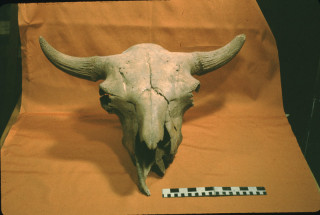Explorer Corps Marker: Rich County
Find the Marker
The Rich County marker is located in the town of Woodruff. You can find it next to the Woodruff sign east of Woodruff Town Park off of S Main Street.
GPS 41°31’12.54”N 111°9’45.6588”W
Dig Deeper
In northeastern Utah, at the base of a cliff, pieces of bone litter the ground. This is not a fossil site, but something much more recent. Around 1,335 years ago, Native Americans drove bison over the cliff above – the makings of what’s now known as Woodruff Bison Jump.
During the 1960s, forestry worker A.R. Standing noticed the bones at the base of the Rich County cliff and reported them to archaeologists at the University of Utah. The University team soon visited and excavated the site, finding not just bison bones but artefacts made by the people who made the site so long ago. Little by little, the picture started to come into focus.
The Woodruff Bison Jump isn’t the only one of its kind. Others have been found across western North America. And herding animals towards a steep ledge is a very old hunting technique. Evidence from a similar site replete with eland bones in South Africa, for example, indicated that people have been using this method for over 100,000 years.

In the case of Woodruff Bison Jump, which is found on the lands of the Ute and Shoshone, archaeologists uncovered over 1,000 bones that belonged to at least 85 animals. That’s a minimum count, of course, based upon what the archaeologists dug up. The total count, estimated from bones left behind as well as those that couldn’t be matched to a particular individual, is upwards of 300. Dozens and dozens of bison were stampeded off this cliff, towering 75 feet above the ravine floor.
The jump was just part of the story, however. Not all the bison died in the fall. Hunters at the bottom would have dispatched any wounded animals. From there, the work of breaking down the bison began. Bison were used to make food, clothes, blankets, ropes, and more. Even the bones of the bison were useful. Hammerstones found at the bison jump indicate that the people broke open bison bones to obtain the marrow inside.
Bison brains, too, were an important resource. Fifteen of the skulls found at the site have holes in the forehead about four to five inches wide. These were made on purpose, skin peeled away from the spot before a hammerstone blow cracked the skull bones. The brain, once removed, could be used to prepare the bison hides taken from the animals.
What was not found at Woodruff Bison Jump offers clues, too. Despite the large number of bison found at the site, archaeologists uncovered relatively few limb bones. These parts of the skeleton would have had a great deal of muscle and other edible flesh on them, and limb bones are more commonly found at ancient Native American campsites in the vicinity. This hints that the hunters carved off the easily-transportable limbs to bring back to camp, much easier than hauling entire bison over the rough country.
Want to Go Farther?
It highlights the Woodruff Bison Jump, a cliff site and ravine near the Utah-Wyoming border that tells the story of a native hunting practice circa A.D. 500 to 750.